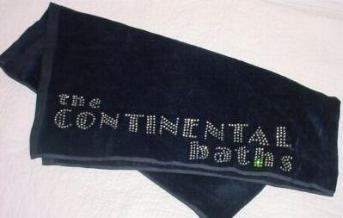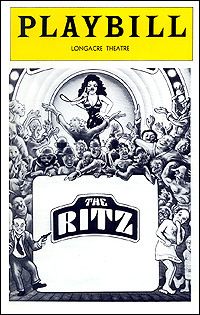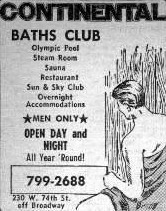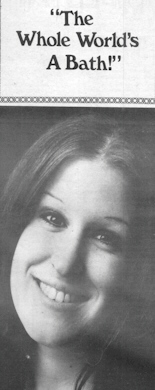
A terrycloth piece of cultural history (see below)
The New Old McNally
Soon there’ll be no gay bars.
When I read that online and elsewhere last week, I wondered if the hypocrites in charge had managed to revive some sort of pre-Stonewall “no queers and booze in the same room” prohibition, a new blue law with lavender highlights.
But I was needlessly alarmed, because it was just entrepreneur.com predicting which businesses and products would vanish within a decade, like roll-film photo developers and tree-eating newspapers, because the need for them would be gone: “Gay men and women have been gaining greater acceptance in society. What used to be a hangout for people who felt unwelcome elsewhere is becoming less necessary.”
Whew. Now my guy and I can walk into that cozy Laramie bar and snuggle over dirty martinis. Single same-sexers may cruise to their hearts’ delight.
Out There predicts that those who wash blood off floors will always have a job.
Certainly many gay bathhouses, at least, have given up the ghost, but there’s a four-letter reason for that. (Guess.) That doesn’t mean there aren’t all kinds of sex-fetish-dating-romance clubs to go to right now, at least in major metropolitan areas. Yes, Virginia, you can meet the love of your life in the strangest of places. But I just saw the just-opened Broadway revival of Terrence McNally’s The Ritz, a mid-’70s farce about an out-of-town married man who hides from his murderous brother-in-law in a New York bathhouse that he doesn’t know is gay — oh, we have a Jack La Lanne in Cleveland, he says.
The playwright has been quoted as saying that he thought it wise to wait awhile before putting The Ritz on again, but enough time has passed.
What does that mean? No one’s seroconverting anymore? We’ve forgotten our dead lovers, family, friends? The author of Love! Valour! Compassion! certainly knows better than that.

Playbill from the ’70s Longacre production
I never saw the original, but I did go to the film adaptation of The Ritz, directed by Richard Lester, when it came out in ’76, the year after Rita Moreno won a Tony for her portrayal of bathhouse cabaret chanteuse Googie Gomez, the play’s only juicy role. The film’s main plus, other than a manic Moreno, is that its plot and dialogue assume that “gay” is out there, sort of normal — albeit sex-centered, albeit despised. That alone made it brave and worthwhile. Otherwise, the movie, which I recently borrowed from my local library’s video collection, huffs and puffs and stays put.
By most reports, the play was a fey Feydeau farce then, and it’s the same now. In spite of some worthy trouping and the usual suburban assortment of bare male buttocks, history has made it worse. Dated. Sad. Unless there are big bucks to be made, why go to the trouble to produce it?
Yet…here’s part of what Pulitzer-winning critic Richard Eder wrote about the film when he reviewed it more than 30 years ago for the New York Times:
But if the farce suffers mainly from wearing lead shoes, the homosexual gimmick suffers from something more serious.
To have a tolerance, or even an acceptance of homosexuality doesn’t rule out having an underlying physical distaste for it. Inevitably perhaps, the camera emphasizes the physical element far more than it was emphasized on the stage. To put it bluntly, it shoves up too close–for most of us, I think–too much pale flesh organized around unshared intentions. There are simply too many male homosexual stomachs, arms and faces at too short a range.
That, good readers, is what we were up against. The diagnostic-sounding term “homophobia” doesn’t quite capture the writer’s marble-pedestal throne tone as well as the unpleasant underlying scent of us-versus-them anxiety. Keep those invert tummies at arm’s length! And Mr. Eder was by no means the worst.
I’ll take this opportunity to climb onto my own slippery pedestal and play historian, with a refresher about the time the gay baths crossed over. Did you see the photo at the top? It shows a black, deco-lettered towel sold by Bloomingdale’s that celebrated an Oct. 4, 1973 performance and RCA recording of Eleanor Steber: Live at the Continental Baths.

The 20,000-square-foot Continental, opened in 1969, was located in the basement of the ornate Hotel Ansonia on Manhattan’s Upper West Side. It quickly lost its gay anonymity and became a destination where slummers could join the lucky, uninhibited regulars (a la Harlem in the ’20s) to hear Peter Allen, Cab Calloway, Melba Moore and the young Bette Midler, Honolulu sunlight still in her hair. Midler, as you probably know, performed with accompanist Barry Manilow, who, in keeping with what was proper, wore a flimsy white towel at the piano.

Diva-to-be
Madame Steber, though, in chiffon and diamonds, draped a black towel around her ample waist. The formidable diva offered Mozart, Charpentier, Puccini and more “while boys yell ‘Brava!’ ” and “Mrs. Leonard Bernstein, Suzy, Patrice Munsel, a lot of Metropolitan Opera stars and half of New York society looked on.” (This reported not by Eder at the paper of record, but by Rex Reed at the Daily News.)
That quite telling and optimistic bit of gay — and opera — history can be heard online via parterre box, the queer opera zine. In his live concert introduction, bathhouse owner Steve Ostrow says that when Steber asked for quiet during rehearsal, she was immediately obeyed: “You could have heard a towel drop.”
He also declares to his audience that the event is taking place “in a house of love.” He means it. Only a few titters can be heard in the background.
Postscript: The Village Voice, where I worked from 1979 to 1995, recently put out a 50th-anniversary issue. From my hundreds of pieces, the editors chose this.
For an automatic alert when there is a new Out There entry, email jiweinste@aol.com.

Oh how I loved the Continental! Saw Bette Midler there several times (she was fabulous. Never saw Eleanor Steber.) And every time I went there (which wasn’t all that often) I’d see Rudolph Nureyv.
When did the man find the time to dance? He was getting poweld constantly in the orgy room by all and sundry (but not yours truly.)
And he had the most enormous feet. Not as big as Susan Sontag’s, but you could hear him coming down the hall a block away.
How was Rosie Perez in the revival? I utterly adore her and it seems like a perfect fit for her blazingly ingratiating personality.